LZY-2
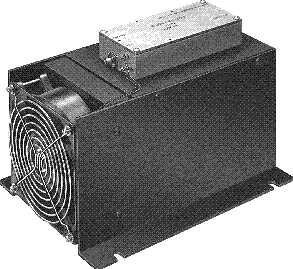
ULTRA LINEAR RF AMPLIFIER 500 MHz - 1000 MHz
20 WATTS MIN., 1 dB COMPRESSION
(40 dB MIN. GAIN)
TABLE OF CONTENTS 1.0 General Description 2.0 Electrical Performance Specifications 3.0 Mechanical Specifications 4.0 Electrical Featuress 4.1 Overdrive Protection
4.2 Thermal Overload Protection
4.3 Reverse Polarity Protection
4.4 Transient Protection
4.5 Shut-off Terminal
4.6 General Caution 5.0 Mechanical Features 5.1 Mechanical Outline
5.2 Heat Sink
5.3 Cooling Fan
5.4 Weight 6.0 Suggested Applications (General) 6.1 AM Amplification
6.2 FM Amplification
6.3 Linear Pulse Amplification
6.4 Broadband 500 MHz - 1000 MHz Swept Signal
6.5 Feedforward Amplification 7.0 Multi-Carrier Amplification (Cellular Band - 869 MHz to 894 MHz) 8.0 Alternative Heat Sinking / Cooling 9.0 Quality Assurance Provisions 9.1 Acceptance Test Procedure 9.1.1 Acceptance Test Procedure Test Setup
9.1.2 Test Equipment List
9.2 Warranty
LIST OF ILLUSTRATIONS Figure 1: Small Signal Response @ -22 dBm Pin Figure 2: Large Signal Response @ -4 dBm Pin Figure 3: Two Tone Performance at 950 MHz Figure 4: Acceptance Test Procedure Test Setup Figure 5: Mechanical Outline Drawing Figure 6: 8 Tone - 2 Watts Average (Total) Random Phase Figure 7: 8 Tone - 2 Watts Average (Total) Synchronous Figure 8: 2 Tone -10 Watts Average (Total) Random Phase
LIST OF TABLES Table 1: Electrical Performance Specifications Table 2: Acceptance Test Setup Equipment
1.0 GENERAL DESCRIPTION The LZY-2 is a low cost, rugged, versatile, 40 dB Gain (minimum), Broadband, Class a Linear RF Power Amplifier Module designed to operate linearly over the 500 MHz to 1000 MHz frequency bands. The LZY-2 features low compression and low harmonic distortion at 20 watts, which make it ideally suited to a wide variety of AM, FM, Pulse and Multi-Carrier applications including cellular service in FEEDFORWARD amplifiers as a Pre Amplifier, Main Amplifier or Error Amplifier. The conservative electrical and thermal design and careful attention to semiconductor ratings insures continued years of service in both the laboratory and many Commercial and Military environments. The workmanship, quality and attention to protective features along with selection of components to COTS (commercial off-the-shelf) guidelines, further enhance applicability and long MTTF which results in low cost-of-ownership. The unit electrical performance is specified at +28 VDC but the unit will operate without damage over the +24 VDC to +30 VDC range. The LZY-2 is supplied with its own high thermal efficiency heat sink and 4 inch ball bearing cooling fan for immediate use and reliable operation. For applications where the heat sink / fan assembly presents a difficult physical fit, the RF linear amplifier module may be removed and operated safely with alternative heat sink / cooling methods if the guidelines in paragraph 8.0 are followed. Operation of the amplifier module without proper heat sinking is not recommended and violates the warranty. Protective features such as Input Overdrive, Reverse Polarity, Transient Protection and Thermal Overload with automatic reset are included. A separate shut-off terminal is provided for remote amplifier on/off control. The LZY-2 was designed to satisfy a range of broad and narrow band multitone or single frequency applications for original equipment, production test and laboratory equipment uses.
2.0 ELECTRICAL PERFORMANCE SPECIFICATIONS The Electrical Performance Specifications and limits are listed in Table 1. Typical broadband small and large signal gain and return loss responses are shown in Figures 1 and 2 respectively. Comparison of the curves and gain data at the measurement points illustrates the dynamic linearity of the LZY-2 across the frequency band. Figure 3 illustrates two tone performance with two 2 Watt tones separated by 1 MHz at 950 MHz. IP3 under these conditions is +53 dBm.
Electrical Performance Specifications and Limits for LZY-1
|
| MODEL NO. | FREQ. MHz | GAIN, dB | POWER, dBM | DYNAMIC RANGE | VSWR | DC POWER | Case Style | connection | Price$ |
| fl | fu | Min | Flatness Max. | Min. Output (1 dB Comp.) | Max. Output (Typ.) | Max. Input (no damage) | NF dB Typ. | IP3 dBm Typ. | In | Out | Volt V. | Max Current (A) | Note B | Qty (1-9) |
| LYZ-1 | 500-1000 | 40 | ±1.5 | +43 | +45 | +10 | 8.0 | 54 | 2.0:1 | 3.5:1 | +28 | 8.0** | BT451 | --- | 2195.00 |
features
- saturated power 32W typ.
- high power with low distortion, -45 dBc typ. harmonics at 20 watts
- wide bandwidth, 500 - 1000 MHz, useful 475 - 1050 MHz
- high gain, 43 dB typ.
- unconditionally stable
- self protected against excessive drive, high case temp., reverse polarity and shorting / unshorting transients at dc input
- electronic shutoff by grounding the shut-off terminal, reduces output by 50 dB. Open circuiting terminal restores ful power
- cool operation with integral fan, 15°C typ. rise
- graceful degradation, +20 to +30V DC
- can withstand short and open circuit at output for 2 minutes while delivering 20 watts.
NOTES:
** At 25W output; includes fan
1. Absolute max. dc voltage: +30V
2. Operating air-ambient temp. for specified performance: -10°C to 50°C
3. Max. storage temp.: -55°C to 100°C
C. Prices and specifications subject to change without notice.
Table 1: Electrical Specifications, -10°C to +50°C Ambient Temperature
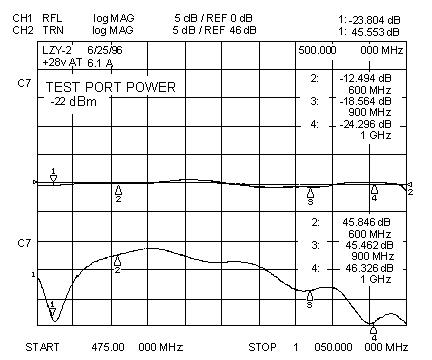
Figure 1: Small Signal Response @-22 dBm PIN

Figure 2: Large Signal Response @ -4 dBm PIN
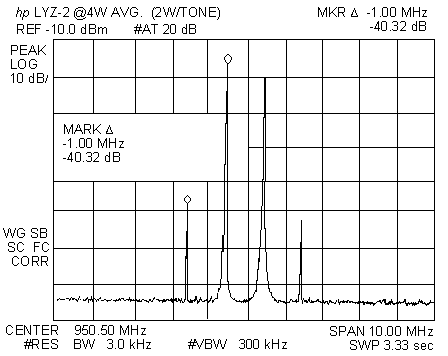
Figure 3: Two Tone Performance at 950 MHz
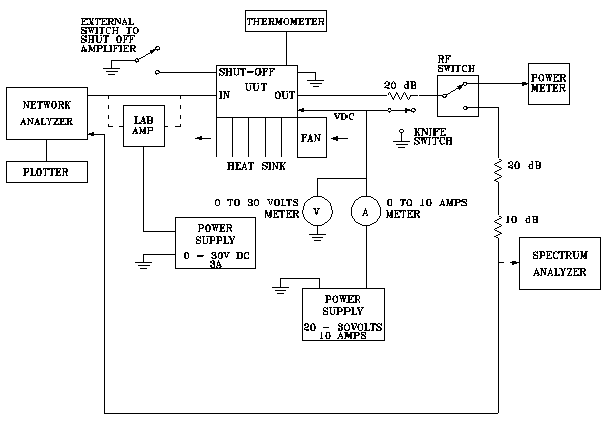
Figure 4: Acceptance Test Procedure Test Setup
Mechanical Outline Drawing & Dimensions
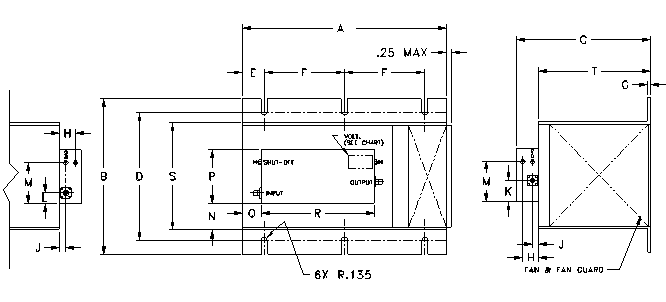
| Case No. | | A | B | C | D | E | F | G | H | J | K | L | M | N | P | Q | R | S | T | wt. grams. | Notes |
| BT451 | inch | 9.50 | 7.3 | 6.3 | 6.00 | 1.00 | 3.75 | .13 | .78 | .31 | 1.48 | 1.48 | 2.45 | 1.1 | 2.95 | .5 | 6.00 | 5.1 | 5.2 | 4000 | A8, D17 |
| mm | 241.30 | 185.42 | 160.00 | 152.40 | 25.40 | 95.25 | 3.30 | 19.81 | 7.87 | 37.59 | 37.59 | 62.23 | 27.94 | 75.00 | 12.7 | 152.40 | 129.54 | 132.08 | | |
A8 : Case material: aluminum alloy. Finish: case irridite. Heat sink: black anodize.
D17: Connectors: female SMA only.
Figure 5 - Mechanical Outline Drawing
3.0 MECHANICAL SPECIFICATIONS
The mechanical outline drawing, mechanical specifications and heat sink mounting details are shown in Figure 5.
4.0 ELECTRICAL FEATURES
4.1 Overdrive Protection The LZY-2 is designed to operate with input drive levels up to +10 dBm without damage at any frequency in the 500 MHz to 1000 MHz range. The unit contains a factory set control for automatic power output foldback to protect internal components from RF input overdrive damage.
Foldback action takes place when the input drive level causes the output power to exceed a threshold. This threshold can vary from 35 watts to 80 watts depending on the input signal frequency. No damage will occur to the amplifier under any of these output power levels.
At threshold, the output power begins to drop. As input drive level is increased, the output power turns down to a low level, safeguarding the amplifier components.
At input drive levels below the threshold, the overdrive protection circuit is inactive and does not affect amplifier performance. The unit will perform within the limits of the specifications of Table 1.
4.2 Thermal Overload Protection
The LZY-2 has an automatic built-in thermal shutoff feature. When mounted on the heat sink / fan assembly supplied with the unit, the LZY-2 is a thermally efficient system that meets the performance parameters in Table 1 in ambient environments from 10C to +50C. The amplifier is factory mounted on the heat sink using a thin film of thermal grease between the RF module and the heat sink mounting surface. (See paragraph 8.0 for operation without the factory supplied heat sink.)
With the fan operational at +28 VDC, the cooling air velocity is approximately 110 CFM.
The combination of heat sink design and cooling air velocity results in a very efficient thermal resistance (0.08C/watt) between the mating surfaces. Under these conditions, the amplifier temperature is held to less than 15C above ambient temperature at 20 watts POut.
When the temperature of the LZY-2 exceeds +65C due to any combination of ambient temperature and / or overdrive, a thermal switch will actuate and shut off the amplifier by shutting off bias to all stages. As the amplifier case cools down near 40C, the thermal switch will reset and restore the amplifier to normal operation.
4.3 Reverse Polarity Protection
The LZY-2 is protected against damage from improper connection of the supply voltage by incorporating a diode in series with the positive VDC terminal.
4.4 Transient Protection
The LZY-2 is protected from damage by DC line transients and accidental shorting at the VDC terminals by a zener protection circuit. This protection circuit is connected to the transistor bias regulator supply and limits (clamps) those transients that would normally pass through the regulator and damage the transistors.
4.5 Shut-Off Terminal
The LZY-2 has a separate EMI-Filtered shutoff terminal and a corresponding ground terminal for use with an external remote shut-off circuit. The nominal RF power output of 20 watts is reduced by 50 dB minimum within 20 milliseconds when the shut off terminal is grounded.
When the shutoff terminal is open-circuited, the RF output is restored within 40 milliseconds.
The voltage present at the shutoff terminal (open circuited) is approximately 11 volts. When grounded, the series current is less than 11 mA.
4.6 GENERAL CAUTION The LZY-2 is designed to operate over the 500 to 1000 MHz frequency band. Do not apply out-of-band RF power signals to this unit below 475 MHz or above 1050 MHz. Attempted operation out-of-band could result in damage or failure of the unit caused by imbalance of the Quadrature Combined Output Transistor Stages.
5.0 MECHANICAL FEATURES
5.1 Outline The outline drawing and dimensional detail are shown in Figure 5.
5.2 Heat Sink
The LZY-2 heat sink is a high thermal efficiency heat sink that, when used with the 4 inch 110 CFM fan, results in a thermal resistance of 0.08C/watt. (See paragraph 4.2 for other thermal considerations).
5.3 Cooling Fan
The cooling fan is a long life, brushless DC operated 4 inch ball bearing "Muffin" fan which delivers 110 CFM air at +28 VDC. The fan is mounted to an optimally designed plenum on the heat sink for minimum air turbulence. The fan is protected by a fan guard. The DC requirement of the fan, as installed, is 300 mA typical, 400 mA max at +28 VDC.
The fan meets EMI standards per FCC Part 15, Subpart J.
5.4 Weight
The LZY-2 amplifier alone weighs less than 1.14 kg. Total weight with heat sink / fan is under 4.0 kg.
6.0 SUGGESTED APPLICATIONS (GENERAL)
The following performance characteristics are those generally expected from the LZY-2 under the conditions stated for each application. The versatility of the LZY-2 ultra-linear amplifier is denoted in each of these applications for AM, FM, Pulse, Multi-Carrier and other signal formats and modulation schemes in applications within the 500 MHz to 1000 MHz frequency spectrum. The suggested performance is provided to the user as an applications guideline which makes the LZY-2 ideal for a variety of driver or output amplifiers in many equipments. Specific results may vary under different conditions.
6.1 AM Amplification
The LZY-2 can be used to amplify an AM (Amplitude Modulated) carrier to a level of 5 watts (20 watts PEP) with less than 5% AM distortion when modulated at 90%.
6.2 FM Amplification
The LZY-2 will typically produce a minimum of 32 watts CW or higher and is limited only by the overdrive threshold limits set by the input signal frequency as described in paragraph 4.1
6.3 Linear Pulse Amplification
The LZY-2 is ideal for linear pulse or pulse train amplification to faithfully reproduce a pulse signature to the 20 to 30 watt peak power level. The pulse width and duty cycle is not limited at these power levels because of the Class A amplifier operation.
6.4 Broadband 500 MHz to 1000 MHz Swept Signal
For swept linear applications at 20 watts, the LZY-2 will accept a constant input and produce an output level within ±1.5 dB (±0.5 dB typical).
6.5 Feedforward Amplification
The LZY-2 can be used as a main amplifier or error amplifier in a cellular band or special mobile radio band feedforward application due to its low IMD and relatively flat phase, delay and amplitude characteristics.
7.0 MULTI-CARRIER AMPLIFICATION (CELLULAR BAND 869 TO 894 MHz)
The LZY-2 RF Linear Amplifier is directly applicable as a candidate for a Main Amplifier in a low power cellular amplifier feedforward system or a Pre-Driver or Error Amplifier in a high power feedforward system. Additional uses are as forward and reverse power amplifiers in bi-directional amplifying system installations.
Figures 6, 7 and 8 illustrate the IMD products of the LZY-2 at several levels of total average RF power output for multi-tone operation with 8 carriers.
The data was taken using the 8-tone RDL Intermodulation Distortion Simulator IMD 801D-03A.
As a Pre-Driver to loop 1 in a feedforward system, the IMD level should be -70 dBc. When used as a Main Amplifier, the IMD should be in the -32 dBc range, and as an Error Amplifier, in the -40 to -50 dBc range. All of these criteria are met by the LZY-2 at various average power levels as illustrated by the Figures.
This data and performance pertains to the 869 MHz to 894 MHz cellular band but could also apply to the SMR band (Special Mobile Radio) between 935 to 940 MHz or any segment of the 500 to 1000 MHz band in which a feedforward system is of interest.
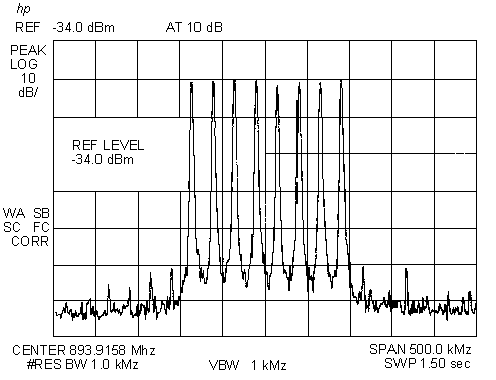
Figure 6: 8 Tone 2 Watt Average (Total) Random Phase

Figure 7: 8 Tone - 2 Watt Average (Total) Synchronous
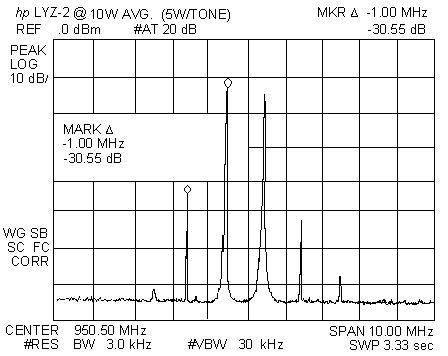
Figure 8: 2 Tone - 10 Watt Average (Total) Random Phase
8.0 ALTERNATIVE HEAT SINKING / COOLING
The LZY-2 RF Linear Amplifier electrical specifications in Table 1 are guaranteed when the RF Linear Amplifier module is operated on the factory supplied heat sink and the cooling fan is running. Physical limitations of certain equipment configurations may require the user to provide alternative methods of heat sinking / cooling.
In these cases, the user can remove the RF Linear Amplifier module from the factory supplied heat sink by disconnecting the wires between the cooling fan and the module then removing the four mounting screws holding the module to the heat sink.
The user must then provide an alternative heat sinking /heat removal method that provides an equivalent thermal resistance of 0.08C/watt to realize the unit electrical performance specified in Table 1. (See Paragraph 4.2 for thermal considerations)
Depending on the approach to cooling, alternative methods may increase or decrease the thermal resistance of that interface resulting in operation of the amplifier at a lower or higher temperature rise above ambient.
A qualified Engineer or Technician should be responsible for designing and evaluating the alternative Heat Sinking method.
Failure to provide the proper heat sinking will result in module overheating which in turn will activate the automatic thermal shutdown circuit when the module temperature exceeds +65C.
9.0 QUALITY ASSURANCE PROVISIONS
9.1 Acceptance Test Procedure All LZY-2 amplifier assemblies are subjected to 100% factory RF testing in accordance with a written Acceptance Test Procedure in which RF performance parameters and electrical features are tested and verified. Certificates of compliance are available. RF performance data is recorded and inspected for conformance within the limits set forth in Table 1.
Currently, each unit is subjected to a DC burn-in test for 72 hours with the input and output ports terminated in 50 ohms. This is a worst case condition for the amplifier since, when terminated, the DC power dissipated in the amplifier circuitry exceeds the amount dissipated when Class A RF power is being generated.
Performance is compared before and after the DC burn-in.
100% DC burn-in testing will continue at our discretion until sufficient history is generated to reduce or eliminate this test.
9.1.1 Acceptance Test Procedure Test Setup
Figure 4 illustrates the test position setup used to perform acceptance testing on the LZY-2 for the majority of the performance parameters specified in Table 1.
9.1.2 Test Equipment
The test equipment required to perform the acceptance tests is detailed in Table 2. In the event any item of test equipment is unavailable, substitution of equivalent equipment is suggested. All test equipment should be turned on 30 minutes prior to start of test.
| Description | Manufacturer | Model |
| Ammeter | HP | 428B |
| Digital Multimeter | Fluke | 8050A |
| Digital Thermometer | Omega | 650 |
| 20 dB Attenuator | Sierra | 662A-20 |
| Spectrum Analyzer | Anritsu | MS2601A |
| Network Analyzer | HP | 8753C |
| Power Meter | HP | 435B |
| Power Meter Sensor | HP | 8482H |
| Power Supply 28V 10 Amps | Various | |
| Plotter | HP | 7470A |
| Terminations, 50 Ohm, 1/2 Watt | Various | SMA-Male |
| Switch (A/B) | Various | |
| Lab Amp (RF Driver) | Mini Circuits | MAV-11 |
| Attenuator 10 dB/20 dB (2W) | Various | |
| Power Supply (0-30V; 3A) | Various | |
| Switch, Knife, High Current | Various | |
Table 2: Acceptance Test Setup Equipment








